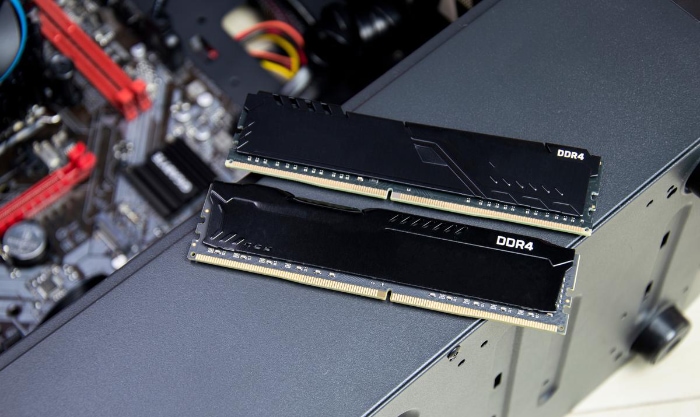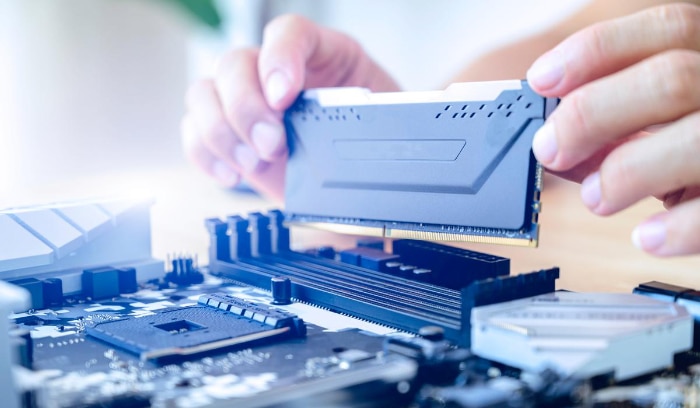DDR4 vs. DDR5: Battle of the Generations

As technology advances rapidly, it's crucial to keep up with the latest developments to understand how they can improve our digital experiences. One such technological advancement is the evolution of RAM (Random Access Memory) from DDR4 (Double Data Rate 4) to DDR5 (Double Data Rate 5).
Computer memory plays an instrumental role in determining the speed and efficiency of your computer, with DDR4 and DDR5 being the most recent iterations in this space. Over the years, we have seen memory modules evolve through DDR, DDR2, DDR3, and DDR4, each leap offering substantial improvements over its predecessor.
Today, we stand at the cusp of another shift with DDR5, promising to take our computing capabilities to new heights. Yet, how much of an improvement is DDR5 over DDR4? Is it worth upgrading to DDR5 or sticking with DDR4? This blog aims to shed light on these questions and give you a comprehensive understanding of these two technologies.
Understanding the Basics
Random Access Memory, commonly referred to as RAM, is a type of computer memory that stores data temporarily for quick access by the computer's processor, also known as the CPU (Central Processing Unit). Think of RAM as your computer's short-term memory.
It remembers everything your computer needs to process data in real-time, but only while the computer is powered on. The more RAM a computer has, the more data it can process simultaneously, leading to smoother multitasking and faster load times.
The Role of RAM in a Computer System
RAM is fundamental to the operation of a computer system. It serves as the bridge between the storage drive (where data is kept permanently) and the CPU.
When you run a program or load a file, the data is pulled from the storage drive into the RAM, allowing the CPU to access and process it much more quickly.
Without RAM, the CPU would need to pull data directly from the storage drive, which would be significantly slower. Therefore, having sufficient RAM is essential for efficient computer operation.
Decoding DDR in RAM
DDR stands for Double Data Rate, and it is a type of Synchronous Dynamic Random-Access Memory (SDRAM). The ‘double' in DDR means that data can be transferred on both the rising and falling edges of a clock cycle, effectively doubling the memory's data rate without increasing its frequency.
The numbers following DDR (e.g., DDR4, DDR5) indicate the generation of the DDR SDRAM.
Each successive generation of DDR has brought increased speed (higher data rate), efficiency (lower power consumption), and capacity improvements. However, each generation is not backward compatible, meaning you can't put DDR4 RAM in a DDR3 slot or vice versa.
DDR4: Understanding its Features, Benefits, and Limitations
Double Data Rate 4 (DDR4) is the fourth generation of DDR SDRAM that has been a standard in computer memory since its introduction in 2014. DDR4 came with several upgrades over its predecessor DDR3, most notably in terms of speed, capacity, and power efficiency.
Key Features of DDR4
Speed
DDR4 introduced a higher standard speed, starting at 2133 MHz compared to DDR3's starting speed of 800 MHz. This increased speed enhances the overall data rate and allows the system to run smoother and more responsive, particularly when multitasking or running memory-intensive applications.
Capacity
DDR4 also improved upon the maximum module size. While DDR3 memory modules were generally limited to 8GB per module, DDR4 pushed this limit up to 16GB per module and beyond, with some high-end modules offering up to 128GB.
This boost in capacity allows for more data to be stored in the memory, increasing the efficiency of the CPU and overall system performance.
Power Efficiency
Another major advantage of DDR4 over DDR3 is its better power efficiency. DDR4 operates at 1.2V, a decrease from the 1.5V used by DDR3. This reduced power requirement translates into lower energy costs and less heat production, making DDR4 a more environmentally friendly option.
Limitations of DDR4
While DDR4 represented a significant improvement over DDR3, it's not without its limitations. The most notable limitation is the cost. When DDR4 was first released, it was significantly more expensive than DDR3.
However, over time, as it became the new standard, the prices have come down.
Another limitation is compatibility. Since each generation of DDR is not backward compatible, upgrading to DDR4 requires a motherboard that supports DDR4 RAM.
Usage and Examples
DDR4 has become the standard in most modern computing devices, including desktops, laptops, and servers, due to its superior speed, capacity, and power efficiency.
Whether it's for gaming, data processing, graphic design, or everyday computing tasks, DDR4 provides a balance of performance and power consumption that meets the needs of most users.
DDR5: The Future of Computer Memory
With the promise of enhanced speed, capacity, and efficiency, Double Data Rate 5 (DDR5) is the latest generation of DDR SDRAM. Released in 2020, DDR5 aims to push the boundaries of what's possible in computer memory, heralding a new era of computational power and efficiency.
Key Features of DDR5
Speed
At the heart of DDR5's advantages over DDR4 is speed. While DDR4 modules start at a base speed of 2133 MHz, DDR5 kicks off at 4800 MHz, providing a substantial boost in memory bandwidth.
This increased speed enables faster data transfers, which can enhance system responsiveness, particularly when running multiple or high-demand applications.
Capacity
DDR5 takes another leap forward in terms of capacity. It doubles the maximum capacity per module compared to DDR4, with potential for modules up to 256GB. This means systems can have more RAM installed, enabling better multitasking and handling of larger datasets.
Power Efficiency
Just like the transition from DDR3 to DDR4 brought reductions in power consumption, DDR5 takes another step in the same direction. DDR5 operates at 1.1V, slightly lower than DDR4's 1.2V. This decrease in power requirement not only makes DDR5 more energy-efficient but also reduces heat output, contributing to the longevity of systems.
Enhanced Features
Beyond the improvements in speed, capacity, and power efficiency, DDR5 also brings in additional features. These include on-die error correction, which improves data integrity and system stability, and a dual-channel architecture that allows each module to operate independently for increased performance.
Limitations of DDR5
While DDR5 has substantial benefits, it's important to note its limitations. DDR5 modules are currently significantly more expensive than their DDR4 counterparts due to being newer technology.
Additionally, as with previous DDR iterations, DDR5 is not backward compatible, meaning you'll need a new motherboard that specifically supports DDR5 RAM to use it.
Usage and Examples
As of now, DDR5 is largely being used in high-end computers and servers that require extreme performance levels. As the technology matures and becomes more widely adopted, we can expect to see DDR5 becoming the standard in consumer-grade computers as well, similar to how DDR4 replaced DDR3.
DDR4 vs. DDR5: A Comparative Analysis

Having explored both DDR4 and DDR5 individually, we now pit them against each other in a face-to-face comparison.
Speed
DDR5 is the clear winner when it comes to speed. With a starting speed of 4800 MHz compared to DDR4's base speed of 2133 MHz, DDR5 delivers more than twice the data rate of DDR4.
This increased speed translates into smoother operation and enhanced system performance, particularly for demanding tasks and applications.
Capacity
DDR5 also takes the lead in terms of capacity. While DDR4 modules can reach up to 128GB, DDR5 doubles this limit to a staggering 256GB per module.
This capacity increase allows for the handling of larger data sets and improved multitasking capabilities, which can be a significant advantage for high-performance computing, server applications, and professional workstations.
Power Consumption
DDR5 comes out on top in terms of power efficiency as well. Operating at 1.1V compared to DDR4's 1.2V, DDR5 uses less power, which can lead to energy cost savings and lower heat output, prolonging the lifespan of your system components.
Compatibility
When it comes to compatibility, DDR4 has the advantage for now simply due to its broader adoption. DDR4 is compatible with most current-generation motherboards, whereas DDR5, being a newer technology, requires motherboards specifically designed to support it.
Performance
Performance-wise, DDR5 offers an improvement over DDR4 due to its faster speed, higher capacity, and added features like on-die error correction and dual-channel architecture. However, the actual performance benefit in real-world usage can vary depending on the specific applications and tasks being run.
Cost
As of now, DDR4 is much more affordable than DDR5. The high cost of DDR5 is mainly due to it being a newer technology. Over time, as DDR5 becomes more widespread and production costs decrease, we can expect its price to come down.
In terms of raw specs, DDR5 has a clear advantage over DDR4 with its higher speed, larger capacity, and improved power efficiency. However, its current high cost and compatibility requirements mean that DDR4 is still the better choice for many users, at least for the time being.
As we look to the future, and as DDR5 becomes more affordable and widely supported, it's likely that it will become the new standard, just as DDR4 replaced DDR3.
The Future of DDR Technology
With DDR5's superior speed, capacity, and energy efficiency, it is set to become the new standard in computer memory as its adoption increases and costs go down. In the coming years, we can expect to see DDR5 increasingly prevalent in everything from gaming rigs and high-performance workstations to servers and data centers.
The technology’s unique features, such as on-die error correction and dual-channel architecture, are also likely to contribute to its adoption, offering enhanced performance and data integrity.
Beyond DDR5: Speculation and Possibilities
As impressive as DDR5 is, it won't be the endpoint for memory technology. Researchers and developers are already looking towards DDR6 and beyond. While details about these future generations are sparse as of now, we can expect further improvements in key areas such as speed, capacity, power efficiency, and added features.
It's also likely that future DDR versions will continue to focus on reducing latency, the delay before a transfer of data begins following an instruction for its transfer. Lower latency can further enhance overall system performance.
Moreover, with trends like AI (Artificial Intelligence) and ML (Machine Learning) requiring increasingly powerful hardware, future DDR generations will play a key role in advancing these technologies.
Implications of DDR5 and Future DDR Generations
As we transition from DDR4 to DDR5 and beyond, there will be notable implications. For consumers, the advent of new DDR generations typically means access to more powerful and efficient devices.
It can also lead to a drop in the prices of previous DDR generations, making powerful systems more accessible to a wider range of users.
For businesses and data centers, advancements in DDR technology can lead to significant improvements in data processing capabilities and energy efficiency, leading to cost savings and enhanced performance.
The development of DDR5 and beyond will also have implications for other technological advancements. Enhanced memory technology can propel forward industries like gaming, AI, 3D modeling, and more, leading to more immersive, intelligent, and sophisticated applications.
As we move forward, it's an exciting time to be part of the ever-evolving world of computer memory. Keep an eye on this space as we continue to explore and unravel the mysteries and potential of DDR technology!


